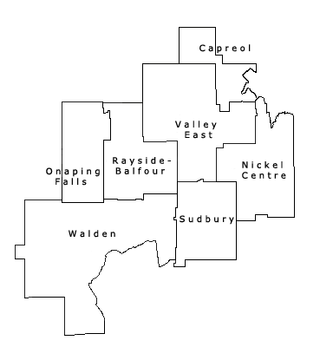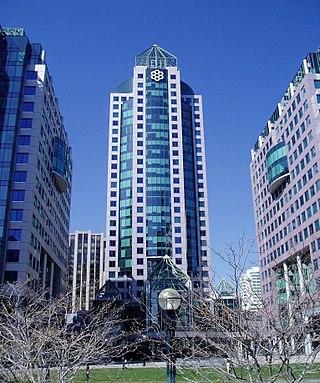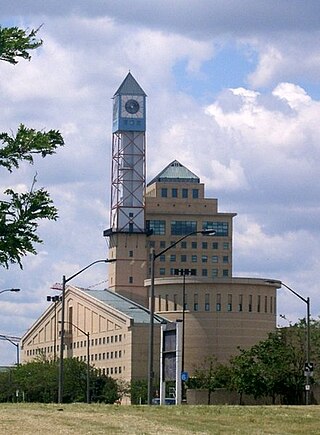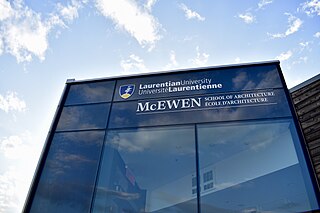
Sudbury, officially the City of Greater Sudbury, is the largest city in Northern Ontario by population, with a population of 166,004 at the 2021 Canadian Census. By land area, it is the largest in Ontario and the fifth largest in Canada. It is administratively a single-tier municipality and thus is not part of any district, county, or regional municipality. The City of Greater Sudbury is separate from, but entirely surrounded by the Sudbury District. The city is also referred to as "Ville du Grand Sudbury" among Francophones.

The Regional Municipality of Sudbury was a regional municipality that existed in Ontario, Canada, from 1973 to 2000, and was primarily centred on the city of Sudbury. It served as an upper-tier level of municipal government, aggregating municipal services on a region-wide basis like the counties and regional municipalities of Southern Ontario, and was the only upper-tier municipal government ever created in Northern Ontario. The regional municipality was dissolved with the creation of the amalgamated city of Greater Sudbury on January 1, 2001.

The Art Gallery of Ontario is an art museum in Toronto, Ontario, Canada, located in the Grange Park neighbourhood of downtown Toronto, on Dundas Street West. The building complex takes up 45,000 square metres (480,000 sq ft) of physical space, making it one of the largest art museums in North America and the second-largest art museum in Toronto, after the Royal Ontario Museum. In addition to exhibition spaces, the museum also houses an artist-in-residence office and studio, dining facilities, event spaces, gift shop, library and archives, theatre and lecture hall, research centre, and a workshop.

Science North is an interactive science museum in Sudbury, Ontario, Canada.
James K. Gordon is a Canadian politician who served as mayor of Sudbury, Ontario from 1976 to 1981 and from 1991 to 2003, and as a Member of Provincial Parliament for the provincial electoral district of Sudbury from 1981 to 1987. He briefly served in the Executive Council of Ontario, holding the position of Minister of Government Services in 1985.

Hong Kong City Hall is a building located at Edinburgh Place, Central, Hong Kong Island, Hong Kong.

Metro Hall is a 27-storey Postmodern-style office tower at the corner of Wellington and John Street in the downtown core of Toronto, Ontario, Canada. It looks out onto Pecaut Square. Part of the three-tower Metro Centre complex, the building was completed in 1992 to house the Municipality of Metropolitan Toronto (Metro) and its employees. The building is now used by the City of Toronto following municipal consolidation in 1998.

The Bahen Centre for Information Technology is a building at the St. George campus of the University of Toronto. It is primarily used by the Faculty of Applied Science and Engineering, the Department of Computer Science and the Department of Mathematics.

The Mississauga Civic Centre is the seat of local government of Mississauga, Ontario, Canada. The 37,280 square metre complex is a prominent example of postmodern architecture in Canada, finished in 1987 by Jones and Kirkland. It stands at 92 metres or 302 feet. The design was influenced by farmsteads which once occupied much of Mississauga as well as historical features of city centres. The building, for instance, includes a prominent clock tower. It was chosen as the winner of a design competition that included 246 submissions. Mississauga Civic Centre is located in the City Centre near Square One Shopping Centre and is home to the Mississauga City Council. The civic center building is considered one of the most iconic and recognizable buildings and cultural icons of Mississauga city.
Thorneloe University, also known as Thorneloe University at Laurentian, is an Anglican affiliated university formerly federated with, and still inset on the campus of, the larger Laurentian University in Sudbury, Ontario, Canada.

The Art Gallery of Sudbury is an art gallery in Greater Sudbury, Ontario, Canada.
The Greater Sudbury Public Library is a public library system in Greater Sudbury, Ontario, Canada.

This is a list of neighbourhoods in the urban core of Greater Sudbury, Ontario. This list includes only those neighbourhoods that fall within the pre-2001 city limits of Sudbury — for communities within the former suburban municipalities, see the articles Capreol, Nickel Centre, Onaping Falls, Rayside-Balfour, Valley East and Walden.

The University of Toronto Mississauga is a satellite campus of the University of Toronto. It is in Mississauga, Ontario, Canada about 33 kilometres west of the main St. George campus. It was formerly called the Erindale College but was later changed to the University of Toronto Mississauga (UTM). The campus has eight main educational buildings: the Maanjiwe nendamowinan Building, Deerfield Hall, the William G. Davis Building, the Kaneff Centre and Blackwood Gallery, the Recreation, Athletic, and Wellness Centre, the Hazel McCallion Academic Learning Centre which holds UTM's library, the Instructional Building, and the new Terrence Donnelly Health Sciences Complex for the Mississauga Academy of Medicine. The campus also houses 3 residence halls: Erindale Hall, Roy Ivor Hall, and Oscar Peterson Hall.

The McEwen School of Architecture, formerly the Laurentian School of Architecture, is an architecture school belonging to Laurentian University in Sudbury, Ontario, Canada. The school opened in September 2013, and was the first new school of architecture to open in Canada in 45 years. It is also the first school of its kind in Northern Ontario, and the first in Canada outside Quebec to offer courses in French.

Place des Arts opened its doors as the first multidisciplinary arts centre in Sudbury, Ontario, Canada, in 2022. The architecture firms Moriyama & Teshima and Bélanger Salach were tasked with designing a building to house seven prominent francophone arts and culture organizations united under the Le Regroupement des organismes culturels de Sudbury (ROCS): Carrefour Francophone, La Galerie du Nouvel-Ontario, Centre Franco-Ontarien de Folklore, Concerts La Nuit sur l'étang, Èditions Prise de parole, Théâtre du Nouvel-Ontario (TNO) and the Salon du livre du Grand-Sudbury.

Bélanger Salach Architecture is a bilingual, full-service architectural firm that is located in Sudbury, Ontario. The firm was founded in 1964 by Arthur Townend along with his partner John Stefura. Since its founding, it has been involved in the design of numerous buildings within the landscape of Sudbury.
Sidney Arthur Townend, was a Cuban-born Canadian architect. Based in Sudbury, Ontario, he designed a number of Sudbury buildings, such as Fielding Memorial Chapel of St. Mark, the Sudbury Civic Square and the Laurentian Hospital.

The Willet Green Miller Centre is a multi-story research laboratory specializing in geological research and testing state-of-the-art geoscience technology. Established in 1990, The building houses many inter-governmental organizations relating to geoscience. The laboratory is located in Greater Sudbury, Ontario, Canada, off the shore of Lake Ramsey. The research laboratory was initially named the Mine & Mills Centre before being renamed the Willet Green Miller Centre after construction. The building is structured in three divisions due to its purpose as a scientific building that houses a variety of governmental subdivisions. The main function of the laboratory is to provide the scientists with an environment that accommodates both the researchers and their equipment.















